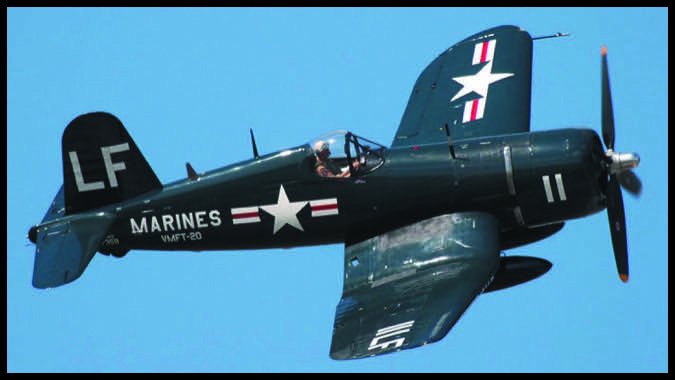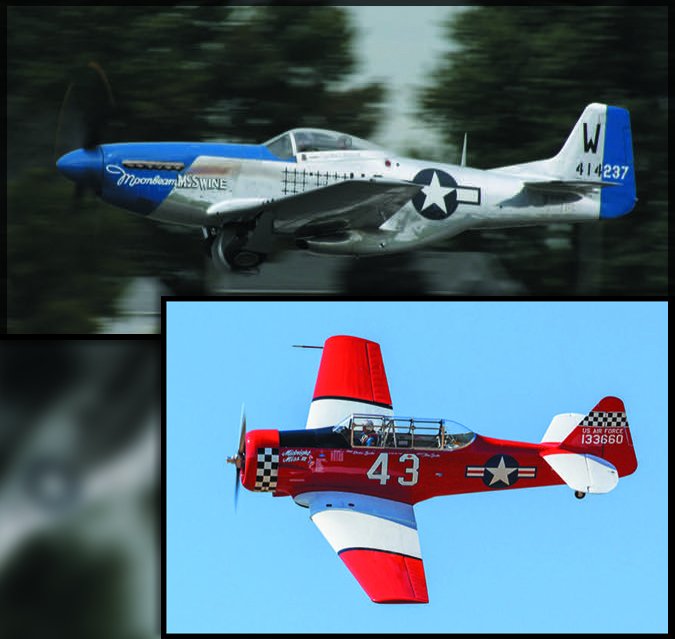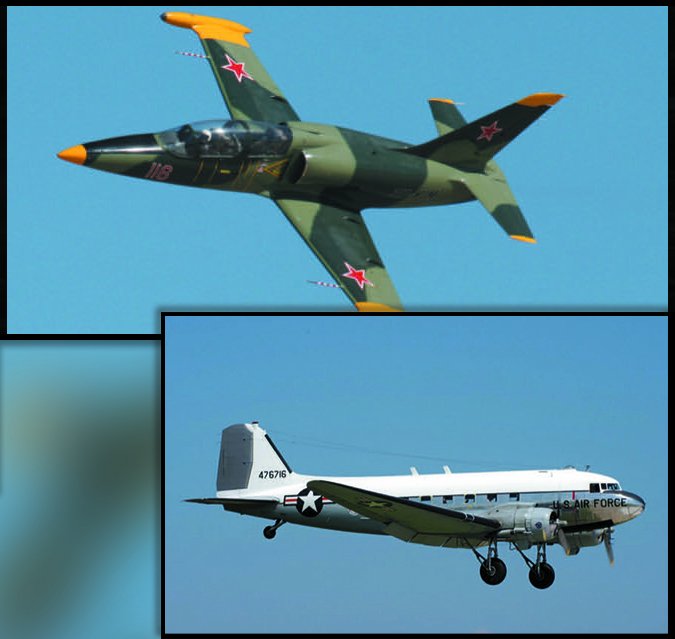
Warbird ownership: “It’s not for the faint of heart, but there’s nothing like it,” according to warbird owner and airshow pilot Stan Musick. While it takes cubic money to acquire and operate big-time warbirds—WWII fighter, bombers and transports and post-war jets—the path toward owning and safely operating an airplane in the major league of general aviation is the same for those armed with bags of money or simply determination: You’ve got to spend quality time in the minor leagues first.
We’ll go into the overall considerations of owning and operating warbirds and then focus on a few examples.
Getting Started
As we were researching this article experienced warbird pilots passed along numerous stories of wrecked machines and injured or dead pilots with a common theme: A wealthy pilot of limited experience, large ego and questionable judgment bought himself a fighter. Due to his hubris, and unwillingness to take more than minimal training, he proceeded to get himself into a jam and took the wrong actions trying to extricate himself.
We were told again and again by experienced warbird pilots that the way to get into warbird ownership is to first do extensive homework into the type of airplane you’re interested in while getting to know those who fly them: Go to airshows and talk with warbird pilots, get on warbird owner forums on the internet and let your interest be known as we’ll as your willingness to listen, and do such things as joining the North American Trainer Association (www.flynata.org) and attending the National Warbird Operator Conference (www.nwoc.aero). Beth Jenkins, instructor in the Commemorative Air Force’s (CAF) B-25 “Devil Dog,” recommended joining the air museum (we’ll use “museum” expansively to include any nonprofit group that operates a warbird) or CAF wing that operates the warbird that interests you and show up for meetings and work sessions. Volunteer to swing wrenches on the airplanes so that you get an intimate introduction to the airplane and its systems.
One warbird owner, who declined to let us use his name, said that it’s also important to get to know the warbird pilots because those who want to own warbirds often also want to fly formation with others and fly in airshows—and it’s important to figure out which pilots you consider good enough to fly formation with.

It’s Time to Buy
In the warbird world, “No Damage History” has no meaning because each airplane probably has one and will almost certainly have been rebuilt or refurbished—the airplanes were built to last six weeks in combat, not 70 years—so the question is the quality of the work. In addition, there is usually a tradeoff between functionality and originality. If originality is your goal, there are airplanes out there that match the way they came out of the factory door (but with better paint). However, those who fly warbirds regularly have recognized that the original panels were not terribly user friendly and have made changes to take advantage of new technology—and probably increase the level of safety.
You have to make a decision as to how close the airplane is to what you ultimately want, how much you’re willing to pay for it as is (we learned that there is often a big difference between advertised warbird prices and actual sale prices) and what you’re willing to pay to get it to the condition you desire.
You may decide to join a CAF wing or a museum under conditions through which you can fly one or more of the warbirds. That usually involves a buy-in under an agreement through which you can fly the airplane so long as you comply with training terms, requirements to put in certain numbers of hours as a volunteer and to be prepared to pick up a share of the tab when something big breaks.
For most used airplanes, the condition of the engine(s) is a major driver in the selling price. We were told that with warbirds it’s slightly less important, even though the Merlin engine that powers the Mustang and Spitfire is only good for something between 300 and 700 hours between overhauls and an overhaul costs north of $150,000. The big radials are much cheaper to overhaul than hot-water 12s—an overhaul of a 2100-HP R-2800 used in the Corsair, Hellcat, Tigercat, Bearcat and Martin B-26 can be had for $90,000.
We’ll take a brief look at a sample of some of the more popular warbirds on the market or in flying museums.
AT-6/SNJ/Harvard
Every service in the U.S. and most of its WWII allies used the AT-6 (AT – Advanced Trainer) as the final step in the training process before putting pilots into fighters, bombers and transports. It is now the transition airplane into the warbird world because it is not forgiving of student mistakes and is at least slightly more difficult to fly than all of the WWII U.S. fighters—with little stall warning, vicious roll-off if the ball is not centered during the stall and an eagerness to burn through at least 2000 feet without hesitation should a pilot inadvertently spin it.
That being said, despite looking fat, slow and sluggish, the T-6 has lightning-quick handling, decent control harmony and does, as Stan Musick put it, “great old-man’s aerobatics.” It is a tremendously fun airplane to fly, has what may be the best aircraft engine ever made, the 600-HP Pratt & Whitney R-1340 (figure $45,000 for overhaul) and there are a lot of them out there so you can find people to fly with.
Fuel burn is 30 to 40 GPH. Owners tell us that maintenance costs run slightly less than on their Bonanzas and that they experience very few unscheduled maintenance issues. Prices for a decent, flyable airplane start at $125,000, with good ones going for as low as $150,000.
Inadvertent—and usually fatal—stalls in the traffic pattern have been the bane of private ownership of T-6s since WWII—as has been low level aerobatics. It may be a trainer, but it has to be flown with a great respect for the fact that it will bite. When we checked out in the T-6 we took to heart the admonition of Randy Sohn, then the chief check airman for the CAF: “The P-51 is a great trainer for the T-6.”
P-51 Mustang
Mustang prices start above $1.5 million for a flyable one. It enjoys a good reputation for easy and reasonably priced airframe maintenance, with parts readily available—most are standard AN components. The North American maintenance manuals are clear and straightforward.
The engine is another matter. The original Mustang (the British gave the airplane its name) had an Allison engine, but its high-altitude performance was anemic. A switch was made to the Rolls-Royce Merlin—which was eventually built in the U.S. by Packard and Continental.
Despite U.S. manufacture, the engine hardware is British standard—you’ll need tools. There are numerous little mods that help make the Merlin more easily maintainable, such as installing a full-flow oil filter, a preoiler and “Merlin fingers”—which replace the chrome pad on the rocker arm that flakes away and damages the cam, with a piece of tungsten. Merlin engines and parts are readily available, they are just expensive. The engine demands regular maintenance by the numbers, with inspections of varying complexity every 25 and 50 hours of operation.
The P-51 has a deserved reputation as being a delight to fly, but with wicked stall behavior (virtually no warning and violent roll-off) and requiring care to avoid uncontrollable left roll when flying slowly and adding power. It is not as light on the controls as the T-6 and has a higher stick-force-per-g curve than the other fighters. It demands major rudder inputs (and rudder trim use) with power and speed changes—a great deal of right rudder when slow, with high power and standing on the left rudder in a dive. Figure on a fuel burn of 80 gallons for the first hour of flight and then 60 GPH in cruise. We were advised to plan on $100,000 per year for operating costs, including fuel, maintenance, insurance, hangar and engine and prop reserve, if the airplane is flown 50-60 hours.

Chance-Vought Corsair
Defining “cool” when it comes to piston fighters, the Corsair went through a number of iterations during its production history. Originally equipped with an updraft carburetor version of the Pratt & Whitney R-2800, which was subject to engine fires, most have been converted to the downdraft carb version used on transport aircraft.
Owners told us to expect an engine life of 1300-2000 hours if flown regularly. One Corsair owner who was not willing to have his name published also said that, unlike a Merlin, the R-2800 gives a great deal of warning when its health starts deteriorating—it leaks and burns more oil, smokes and becomes hard to start.
As with most WWII airplanes, the airframe was built to be maintained by kids just off the farm, with some exceptions—one is a complicated hydraulic system that got more complex as the airplane evolved. The final versions had hydraulically boosted controls and even a hydraulically actuated canopy. Nevertheless, owners told us that the system rarely causes problems so long as the hoses are changed periodically. One told us that he had hydraulic ills that were only solved with replacing the 62 lines—which hadn’t been done in over 20 years. Airframe sheet metal work is expensive due to the compound curves involved and the use of spot welding rather than rivets.
We were told that annuals run between $6000 and $35,000. One owner compared his overall yearly operating costs to those of a Cessna 421.
There are no dual-control Corsairs, so most pilots move into one either from other fighters or a few hundred hours in a T-6. Control forces are astonishingly light for what is a massive airplane. It “does not fly like a T-6,” we were advised; it’s easier and much better flying. However, as one pilot told us—where the T-6 will roll steeply after an uncoordinated stall, the Corsair will roll past the vertical.
The airplane has a reputation for excellent handling (except in a stall) to the extent that one owner said that, “If you can figure out how to start it, you can probably fly it.” Where no tailwheel fighter has great three-point visibility, the later Corsairs are better than most as the cockpit and seating position were revised forward and upward to improve the airplane’s ability to operate from aircraft carriers.
Plan on a fuel burn of 100-110 gallons for the first hour, then 80 GPH after that.
Douglas C-47/DC-3
From a pilot’s standpoint, the C-47/DC-3 is mostly a delightfully docile, honest-flying airplane with some of the best ground manners of any tailwheel bird. There are exceptions lurking in corners of the flight envelope: Three point landings are dangerously unpredictable and can damage the airframe and, because it is a swept-wing airplane, taking one into a full stall may cause you to exceed your adventure quotient for the month as it rolls off and potentially spins. The airplane is also unforgiving to the pilot who does not know its systems. The Hamilton Standard propeller feathering and unfeathering system has a failure mode that can lead to loss of the airplane.
While there is no maximum operating speed for the landing gear, raising and lowering it involves moving two floor-mounted levers in the correct sequence or risking jamming the gear in some intermediate position. In addition, the airspeed and power settings must be monitored carefully so that the props are never “driving” the engines during descent—the reverse loading will cause bearing failure.
A few years ago you couldn’t give away a DC-3 with passenger seats. Now, with museums and individuals desiring DC-3s/C-47s for excursion machines or personal airplanes, our survey indicated they command prices in excess of $300,000 as compared to $150,000 for a freighter.
Because C-47s did and still do spend time parked outside, corrosion can be an issue, but it tends to be limited to a few areas such as the plates over the fuel tanks and the wing/nacelle attach area.
If considering a purchase, look over the hat section on the tailwheel support—a blown three-point landing can damage it and repair involves expensive sheet metal work. The symptom of damage is that the airplane won’t taxi straight.
There were three types of brakes installed on the C-47. According to longtime owner and operator Bob Steenbock, all are satisfactory. The “truck” brakes are the least expensive, but heat up and fade, so avoid short fields; the expander tube type are effective but parts may be hard to get; while most expensive, the Goodyears are the best.
Adding to the cost of maintenance on the airplane is its size, requiring appropriate equipment to gain access to the portions that need attention.
DC-3s/C-47s were equipped with both Wright and Pratt & Whitney engines, with the 1,200-HP Pratt & Whitney R-1830 now almost uniformly the engine of choice. Overhauls currently start at $28,000, depending on the condition of the engine to be overhauled. While there aren’t any new parts being made—everything is being overhauled—there doesn’t seem to be a shortage, although we heard some questions about crankshaft availability.

The Jets
Over the last 30 years the idea of private ownership of a jet warbird went from “Are you nuts?” to almost routine. Not long after the Iron Curtain fluttered into history, Soviet-bloc trainers and fighters began following the money to the U.S. It’s not unusual to see a MiG at an airport with a long runway and the Czechoslovakian Aero Vodochody L-39 Albatross two-seat trainer has become ubiquitous and even has its own racing event at Reno.
Thus far the eye-watering price tag increases that hit the piston warbirds in the early 1980s haven’t reached the jets—perhaps because of the cost of feeding them Jet A. An L-39 in good condition can be had for $250,000 if you’re ready to supply it with 150 gallons of fuel per hour. Larry Salganek of Jetwarbird Training Center in Santa Fe, New Mexico (www.jetwarbird.com) told us that its performance and handling are predictable (by the 1960s stability and control was understood), with few bad habits other than the slow spool-up time common to older jet engines. For pilots with some high-performance or jet experience, he advises that a transition can be made into the jet—including checkride—in five to nine hours.
Salganek said that annual operational costs include $15,000 for insurance, $6000 to $20,000 for maintenance and a reserve for the 1000-hour engine TBO ($150,000 for overhaul) and the APU ($30,000 overhaul). He told us that the L-39 has the lowest unscheduled maintenance cost for any warbird he’s ever flown.
When asked, Salganek said that for a sea-level home base for the airplane, he’d recommend a minimum runway length of 4000 feet.
We inquired about the fighter end of the jet warbird spectrum and were told that MiG-15s are the most readily available. Salganek went on to say that it is an entirely different animal from the trainers. Bluntly put, it’s a 1947, swept-wing airplane that reflects the technology of the time: Handling is not good—it is not docile and it has a number of control issues that require intimate knowledge of the airplane—it likes long runways and its first-generation turbojet sucks down fuel at a rate of 300 GPH. However, on the bright side, you can buy an engine for $15,000 and there are plenty available.
Conclusion
They’re big, they’re fast and the rush you get flying one is like nothing else in aviation. Nevertheless, warbirds are products of an earlier time of aeronautical knowledge and their systems design and handling quirks and vices are simply unknown in modern airplanes. Accordingly, they can bring a modern pilot who shows up with big ego, big cash and a lack of respect to grief in a hurry.
We think that stepping into the world of warbird ownership must be done with patience, humility and a willingness to learn everything possible about the airplane, its systems and handling. Otherwise, the chances are that if you wreck one, it will be the airplane that is mourned, not you.


